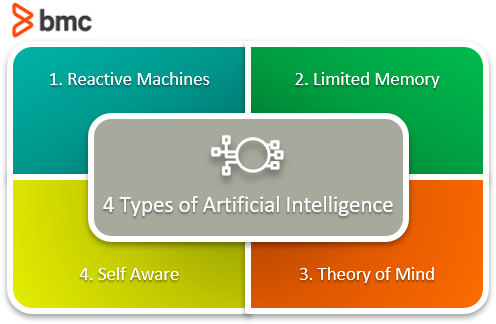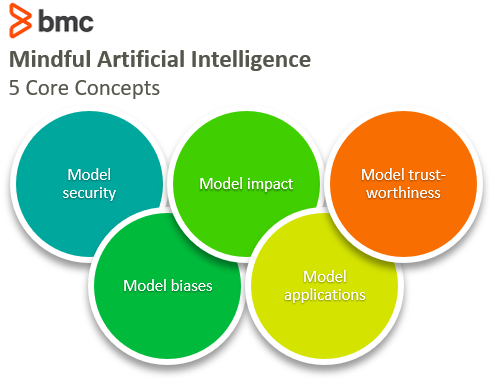Artificial Intelligence is a technology designed to make calculated decisions. Machine Learning is a subset of Artificial Intelligence that refers to the engineering aspects of AI. Under the umbrella of Machine Learning are a variety of topics, such as:
- The different maths used to predict AI’s outcomes
- Data collection and labelling
- Resource provisioning to power the AI
The public and the engineers view AI with artistic differences. Where engineers see AI as a tool that cooperates with humans in order to enhance human life, a lot of the public sees AI as an entity that overpowers humans.
Why are these views so different? Let’s take a look.
Artificial Intelligence overview
Artificial Intelligence is a term used to imbue an entity with intelligence. People create AIs. Instead of hiring teams of people to answer phone calls, engineers can create an AI who acts as the phone system’s operator. An artificial intelligence can be created and used to handle all the incoming phone calls. People don’t have to sit around waiting for an operator, and operators don’t need to be trained and staffed at companies.
Artificial Intelligence’s greatest value is that it can do simple repetitive tasks—and do them exceptionally well. AI can free people from performing monotonous duties so they can pursue more creative outlets.
In a sense, people are freed from having to align their purpose with the company’s mission and can set out on a path of their own—one filled with curiosity, discovery, and their own values.
4 AI types
There are four types of AI accepted by the community. At each level, the four types increase in ability, similar to how a human grows from being an infant to an adult.

- Reactive Machines. A.I. makes basic inferences on a topic.
- Limited Memory. A.I. has a memory and can learn.
- Theory of Mind. A.I. begins to interact with the thoughts and emotions of humans.
- Self Aware. A.I. recognizes and negotiates for its own existence.
The current status of AI systems resides at Stage 2. Here, at most, AI systems are capable of making decisions from memory, but they have yet to obtain the ability to interact with people at the emotional level.
Moral issues in AI
AI surfaces a number of moral questions. One is allowing people to ask questions about designing societies—both utopian and dystopian views are formed. Where those creations have been the topics of novels for a while, the questions the books have posed are, today, reality.
Should Facebook ban users from its platform? If a person’s post is the “chosen” post, social media companies can see it and have the power to raise those posts to fame or to cut them off shortly after their creation.
If they see a new riotous group forming to disturb the new world order, they have the ability to stop the group early and forbid them from the platform. The companies have to ask, “How far do we go?”
Facebook’s reach is worldwide and the decisions it makes can make or break a person on its platform in an instant. Google Search can do this. Twitter. Spotify. YouTube. The questions these companies face are around the structures of societies. And the use of large technological systems and AI pose real questions to both user and company.
AI poses moral concerns. Focal points for moral consideration are:
- Privacy
- Jobs
- Discrimination
- Fiduciary duties
One way to handle this moral concerns might be through mindful AI—a concept and developing practice for bringing mindfulness to the development of Ais.

Human-AI Integration: Cyborgs
Artificial Intelligence also has the ability to impact the ability of the individual human, creating a superhuman. Some people think the introduction of AI is anti-human, while some openly welcome the chance to blend human intelligence with artificial intelligence and argue that, as a species, we already are cyborgs.
AI helps doctors diagnose patients. AI helps drivers operate their cars. AI helps train Chess and Go players.
Our traditional way of navigating through life—having always relied on our own ability to absorb information and make decisions—is getting an upgrade to include an ever present, personal companion that can increase our own ability.
The “We are already cyborgs” idea looks at the phone in our pockets as the first, very remedial, step towards the eventual cyborg. All the information of the web is at our fingertips, and communication with others is instant.
Machine Learning overview
Machine Learning is the field of study that makes the AI happen.
ML theory
There are 5 tribes of Machine Learning. Each tribe comes to the engineering aspect from different points of view, but they all converge on one: Artificial General Intelligence (AGI) is possible. AGI is the notion that there exists one model that can know everything.
In 2020, machine learning is for everyone. It’s not just a skill reserved for PhD candidates, but for any programmer. Machine Learning engineers are measured by where they spend their time: research or coding.
- Research concerns itself with optimizing architectures in various ML algorithms to improve model efficiency, accuracy, or possibility.
- Coding is the daily practice of actually programming and building an operating AI system—something known as ML Operations (MLOps).
ML in practice
Beginning programmers start with simple predictions—the Type 1 AI. But Machine Learning reaches far beyond that. Machine Learning models require:
- Gathering data
- Training models
- Deploying models
- Maintaining regularly
Possessing a Machine Learning model is like owning a ship—it needs a good crew to maintain it. People are needed and, with it, new kinds of jobs are created.
For ML, creating a model is not the only aspect of machine learning. As the open source Machine Learning software toolkit KubeFlow likes to point out, there are a lot of aspects to machine learning, and managing it all is complicated. (That’s where KubeFlow helps out.)
For example, some aspects to Machine Learning are:
| Sourcing Data | Building Models | Deploy Models |
|
|
|
AI vs ML
The easiest way to sum it up? All machine learning falls under the AI umbrella. But artificial intelligence is much more than only machine learning.
Related reading
- BMC Machine Learning & Big Data Blog
- BMC AIOps Blog
- Machine Learning, Data Science, AI, Deep Learning & Statistics
- State of AI in 2021
- Top Machine Learning Frameworks To Use
- Guide to ML with TensorFlow & Keras, a tutorial series
- GPT-3 Explainer: Putting GPT-3 Into Perspective
These postings are my own and do not necessarily represent BMC's position, strategies, or opinion.
See an error or have a suggestion? Please let us know by emailing blogs@bmc.com.





